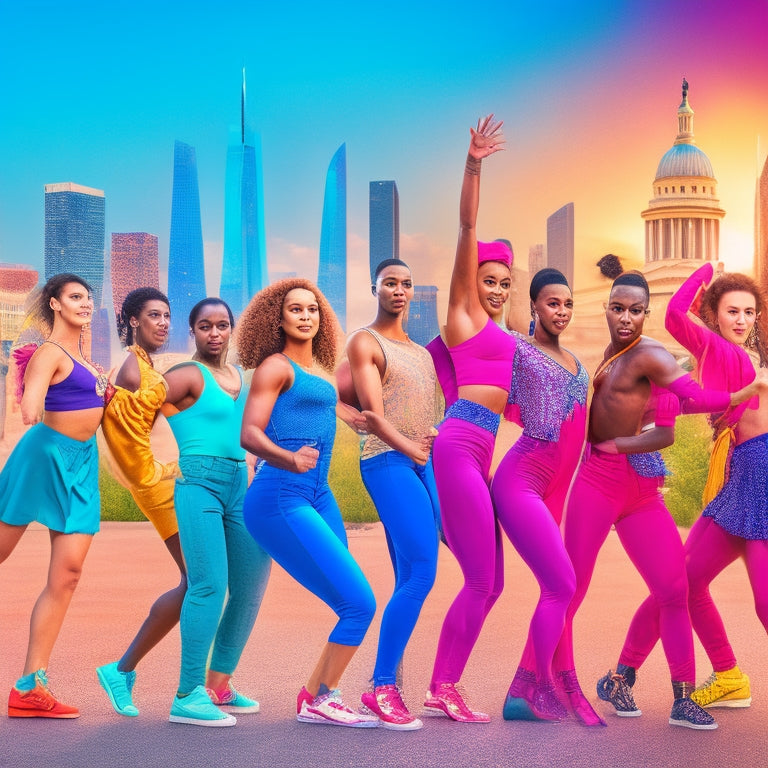
Discover Dance Scene: Study in the US
Share
The United States is a hub for dance education, offering a diverse range of programs and opportunities for international students to immerse themselves in its vibrant dance scene. From classical ballet to hip-hop, various dance styles are available, with programs leading to Bachelor of Fine Arts, Bachelor of Arts, and Certificate degrees. State-of-the-art facilities and renowned choreographers provide ideal conditions for artistic growth. To pursue dance studies in the US, international students must navigate visa requirements, including F-1, J-1, H-1B, O-1, and P-1 visas. As you explore the American dance landscape, discover how to tap into its creative energy and unleash your full potential.
Key Takeaways
• Study dance in the US and choose from various styles like classical ballet, contemporary, hip-hop, and more.
• Pursue a Bachelor of Fine Arts, Bachelor of Arts, or Certificate program in dance at a US university.
• Engage with renowned choreographers and dancers, and access state-of-the-art facilities and performance venues on campus.
• Immerse yourself in the rich cultural landscape of the US dance scene, exploring diverse styles, genres, and communities.
• Understand visa requirements and opportunities for international dance students, including F-1, J-1, H-1B, O-1, and P-1 visas.
Exploring Dance Programs in US
The United States boasts a diverse range of dance programs, offering international students a unique opportunity to explore various styles, from classical ballet to contemporary, hip-hop, and beyond, at top-ranked institutions across the country.
With numerous program options available, students can choose from Bachelor of Fine Arts, Bachelor of Arts, or Certificate programs, each catering to different interests and career goals.
Campus life is also an essential aspect, with many institutions offering state-of-the-art facilities, performance venues, and opportunities to engage with renowned choreographers and dancers.
Additionally, scholarship opportunities and performance opportunities abound, providing students with a holistic dance education that prepares them for a successful career in the industry.
Navigating Visa Requirements
International students pursuing dance studies in the US must navigate a complex web of visa requirements, which can be a challenging task without a thorough understanding of the necessary procedures and regulations. To guarantee a seamless visa application process, it is imperative to comprehend the legal requirements and obligations that come with obtaining a student visa.
| Visa Type | Eligibility | Work Opportunities |
| F-1 | International students enrolled in dance programs | Part-time on-campus employment, off-campus work with authorization |
| J-1 | Exchange visitors, including dance students | Limited work opportunities, dependent on program sponsor |
| H-1B | Temporary workers, including dance professionals | Specialized knowledge or skills, limited availability |
| O-1 | Individuals with extraordinary ability, including dancers | High-level achievements, limited availability |
| P-1 | Athletes, entertainers, and artists, including dancers | Internationally recognized, group performances |
Understanding the nuances of each visa type and its corresponding work opportunities is vital for international dance students to make informed decisions about their academic and professional pursuits in the US.
Immersing in US Dance Culture
As international dance students navigate the complexities of visa requirements, they can finally turn their attention to the rich cultural landscape of the US dance scene, where diverse styles, genres, and communities await exploration.
Immersing in US dance culture offers a unique opportunity to engage in cultural experiences that foster personal growth and artistic development. By attending performances, workshops, and festivals, students can connect with local dancers, choreographers, and directors, forging valuable community connections that can last a lifetime.
These interactions can also provide valuable insights into the American dance scene, allowing students to develop a deeper understanding of the cultural context that shapes the art form.
Frequently Asked Questions
What Are the Average Tuition Fees for Dance Programs in the Us?
When crafting a dance budget, consider fee variations: on average, tuition fees for dance programs in the US range from $20,000 to $50,000 per year, with private colleges typically being more expensive than public institutions.
Can I Work Part-Time While Pursuing a Dance Degree in the Us?
International students pursuing a dance degree in the US can work part-time on-campus, but visa restrictions apply; campus jobs, such as teaching assistantships or dance instructors, are viable options, but off-campus employment is generally prohibited.
Are There Dance Scholarships Available for International Students?
"Overcoming the misconception that international students are ineligible for dance scholarships, many institutions offer competitive awards to talented dancers, recognizing international talent through rigorous dance auditions, providing opportunities for global artists to shine in the US dance scene."
Do US Dance Programs Offer Specializations Like Ballet or Contemporary?
US dance programs offer specializations like ballet, contemporary, and more, with rigorous audition processes, expert dance faculty guidance, abundant performance opportunities, and a focus on choreography, enriched by collaborations with esteemed guest artists.
Can I Transfer Dance Credits From My Home Country to a US Program?
When transferring dance credits from your home country to a US program, a thorough Credit Evaluation is essential. International Articulation agreements facilitate this process, enabling a seamless handover.
Related Posts
-

Get Certified in Dance Makeup With Online Courses
You can gain a recognized certification in dance makeup through online courses, which demonstrate your expertise and ...
-

What Inspires Your Dance Makeup Looks Online?
Your online dance makeup looks are shaped by a dynamic mix of YouTube tutorials, Instagram inspiration, expert advice...
-

3 Best Online Tools for Organized Dance Makeup Artists
You need online tools to streamline your workflow and deliver exceptional service to your dance clients. For seamless...


